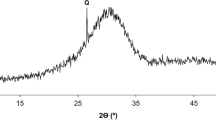Abstract
One of the principal uses of supersulfated cement has been for structures exposed to sea water and sulfate bearing ground waters. The resistance to such environments has been related to the absence of calcium hydroxide and the combination of much of the free alumina into ettringite during hydration. This paper reports the resistance of SSC to sulfate solutions in which ettringite has been decomposed. Prism samples were subjected to initial water storage at 25°C for both 28 days and 6 months. Samples were also cured for 6 months at 95°C and at both 11% and 100% R.H. The control samples of 28 days were compared with the 6 months samples of a more mature undecomposed SSC paste. After curing the prisms were measured and all the samples were immersed in three sulfate solutions (0.7M Na2SO4 , 0.7M MgSO4 and saturated CaSO4), and water at the same time. Measurements of linear expansion over 6 months were carried out. Core and surface material following immersion was examined by DTG and XRD. The study indicated that SSC is resistant to sodium and calcium sulfate solutions. Strong magnesium sulfate solutions decomposed the samples under all conditions. A possible mechanism for this attack is suggested.
Similar content being viewed by others
References
J. Bijen and E. Niel, Cement & Concrete Res., 11 (1981) 307.
T. Grounds, D. V. Nowell and F. W. Wilburn, J. Therm. Anal., 41 (1994) 687.
F. M. Lea, The Chemistry of Cement and Concrete, 4th Edition, P. C. Hewlett (Ed.), Edward Arnold, London 1998, pp. 660-669.
H. F. W. Taylor, Cement Chemistry. 2nd Edition, Thomas Telford, 1997, p. 240 and p. 400.
P. K. Mehta and O. E. Gjorv, J. Test Eval., 2 (1974) 510.
P. W. Brown, Cem. Concr. Res., 11 (1981) 719.
L. Bien-Dor, Advances in Cement Technology, S. N. Ghosh (Ed.), Pergamon Press, London 1983, pp. 673-710.
J. Dweck, P. F. Ferreira da Silva, P. M. Büchler and F. K. Cartledge, J. Therm. Anal. Cal., 69 (2002) 179.
T. Grounds, D. V. Nowell and F. W. Wilburn, J. Therm. Anal., 45 (1995) 385.
A. I. Vogel, Quantitative Inorganic Analysis, 3rd Edition, Longmans, 1961.
T. Grounds, H. G. Midgley and D. V. Nowell, Thermochim. Acta, 135 (1988) 347.
Author information
Authors and Affiliations
Corresponding author
Rights and permissions
About this article
Cite this article
Grounds, T., Nowell, D.V. & Wilburn, F.W. Resistance of supersulfated cement to strong sulfate solutions. Journal of Thermal Analysis and Calorimetry 72, 181–190 (2003). https://doi.org/10.1023/A:1023928021602
Issue Date:
DOI: https://doi.org/10.1023/A:1023928021602




